Tag - AIoT Applications
Blog , March 24, 2024 , AIoT Applications, ChatGPT, Future of IoT, Generative AI, Generative AI in IoT, IoT Code Generation, IoT Innovation, Robotics Control, Social IoT Devices
Exploring the Convergence of AI and IoT: Innovative Applications Transforming Industries
Exploring the Convergence of AI and IoT: Innovative Applications Transforming Industries
The integration of Artificial Intelligence (AI) with the Internet of Things (IoT), known as AIoT, is revolutionizing how data is collected, analyzed, and utilized across various sectors. The synergy of AI’s data processing capabilities with IoT’s network of interconnected devices creates a landscape ripe for innovation, efficiency, and enhanced decision-making. From smart homes to industrial automation, the applications of AIoT are vast and continue to expand as the technologies evolve.
One of the most prominent applications of AIoT is in smart homes and cities. Here, AIoT systems optimize energy consumption, improve security, and increase comfort through intelligent automation. For example, smart thermostats learn from your habits to adjust heating and cooling for maximum efficiency and comfort, while smart security systems can distinguish between regular activity and potential threats, alerting homeowners only when necessary.
In healthcare, AIoT is making strides in patient monitoring and care. Wearable devices equipped with sensors provide real-time health data to both patients and healthcare providers. AI algorithms can analyze this data to detect abnormalities or predict potential health issues, enabling proactive care and personalized treatment plans. Remote patient monitoring has become particularly important, allowing for continuous care while reducing the need for in-person visits, a vital advantage during times like the COVID-19 pandemic.
The industrial sector is harnessing AIoT for predictive maintenance and operational efficiency through what is known as Industry 4.0. Sensors on machinery provide a constant stream of data, which AI systems use to predict equipment failures before they occur, minimizing downtime and maintenance costs. Moreover, AIoT facilitates smarter supply chains, where inventory levels, logistics, and distribution are optimized in real-time, drastically improving efficiency and reducing waste.
In the realm of agriculture, AIoT applications are ushering in an era of precision farming, where farmers use data from soil sensors, weather information, and satellite imagery to make informed decisions about planting, irrigation, and harvesting. This targeted approach maximizes crop yields, reduces resource consumption, and can even help in monitoring the health of livestock through wearable sensors, enhancing the overall productivity of the agricultural sector.
The transportation and logistics industry benefits significantly from AIoT through improved fleet management, route optimization, and autonomous vehicles. Real-time data from IoT devices combined with AI analysis can reduce fuel consumption, optimize delivery times, and enhance safety. Moreover, as autonomous vehicles become more prevalent, AIoT will be fundamental in ensuring these vehicles can safely navigate and interact with their environment.
Despite the vast potential, the deployment of AIoT comes with challenges such as data privacy, security, and the need for robust and reliable connectivity. Ensuring that data is kept secure and private is paramount, as is the development of standards and protocols to facilitate seamless integration of AI and IoT technologies.
In conclusion, AIoT applications are transforming industries by enabling more intelligent and responsive systems. As the technology matures, it holds the promise of making our world more efficient, sustainable, and responsive to our needs. The convergence of AI and IoT is not just a technological evolution; it’s a revolution that will redefine the boundaries of what is possible in the digital age.
